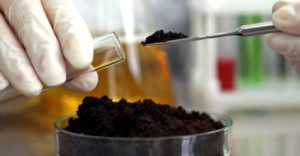Genetically Modified Soil Microbes May Have ‘Irreversible Consequences’ — Recent Report
A plan by major agrochemical companies to develop genetically engineered (GE) soil microbes, including bacteria and fungi, to act as pesticides and fertilizers is raising concerns about the unknown and potentially disastrous risks associated with the new organisms, according to a report published recently by Friends of the Earth.

Bayer-Monsanto, Syngenta and BASF are among the chemical giants known to be developing the microbes which, according to the report, are fundamentally different from the already controversial genetically modified organisms (GMOs) that have existed for decades.
GE microbes are living organisms that share their genetic material easily with other species and travel vast distances in the wind. And because they are microscopic, their numbers are vast.
“An application of GE bacteria could release approximately 3 trillion genetically modified organisms every half an acre — that’s about how many GE corn plants there are in the entire U.S.,” said Dana Perls, food and technology manager at Friends of the Earth, in a press release.
Introducing GE microbes into agriculture represents an “unprecedented open air genetic experiment,” the report says. “The scale of release is far larger, and the odds of containment are far smaller than for other GE crops.”
Scientists understand the role and function of less than 1 percent of the billions of existing species of microbes or “biologicals.”
Yet the race is on by biotech and agrochemical companies to develop, modify and patent new microbes to capture a share of the biologicals market, which is set to triple in value to $29.31 billion by 2029.
At least two GE microbes, Pivot Bio’s Proven and BASF’s Poncho Votivo seed treatments, are already being used by U.S. farmers on millions of acres of farmland.
“GMO companies are putting GM microbes into the open environment, yet no one has the first idea of what risks this might present,” Claire Robinson, co-director of GMWatch told The Defender. “And there is absolutely no need to take these risks and no proof that the GM microbes actually work in the way that’s claimed.”
“The latest science shows that engineering organisms can result in unintended genetic mishaps,” said Kendra Klein, Ph.D., deputy director for science at Friends of the Earth and author of the report. “And there are rare but potentially disastrous risks of creating an invasive species or novel human pathogen.”
Klein added, “The release of GE microbes across millions of acres of farmland is an open-air genetic experiment that may have irreversible consequences. Once they are released, GE microbes cannot be recalled.”
The report provides a historical context for understanding the new technology, details a number of future trends and potential concerns and makes urgent policy recommendations for assessing and regulating GE microbes.
Big ag: Regenerative agricultural leaders ‘feeding the world’?
In recent years, growing numbers of scientists and farmers have studied the relationship between the microbiome, which is the aggregate of microbes living in the soil, and soil health.
These tiny microorganisms play an outsized role in healthy plant growth, building soil structure, mobilizing nutrients, providing crops with immunity to pests and diseases, and fixing carbon and nitrogen. And they form symbiotic relationships with other species, like plants.

With that knowledge, regenerative agriculture has emerged as a movement focused on improving soil health, plant health and ecosystem health to counter the damage done by industrial agriculture and build a more resilient system.
Regenerative farmer Gail Fuller explained the philosophy behind his farming practices. For thousands of years, Fuller said, “plants, animals and microbes lived in harmony,” but people disrupted that dynamic.
Fuller said:
“We have spent the last few thousand years trying to conquer, kill and control, all in the name of ‘feeding the masses.’ We have eroded away much of our topsoil and killed off many of the species that we thought were unimportant.
Somewhere along the way, some farmers began to realize we had gone too far and started looking for a better way. We learned how to plant without tillage. We realized the soil was alive with microbes and we began to study and understand them. We saw what Mother Nature has been trying to show us all along. The beauty of life.
Once we learn to quit conquering and work with nature we see life return in full force and the nutritional value of the food we grow, which has been declining for decades, begins to climb.
When we learn to focus on life and we start working with the system (diversity of crops, cover crops, livestock, etc.) microbes and wildlife return. We can easily grow enough food without synthetic fertilizers, chemicals, GMO crops and microbes.”
As regenerative farmers like Fuller look to the microbiome to develop new forms of sustainable agriculture and recuperate key dynamic relationships in nature, other actors have recognized their potential to deliver big profits.
Billionaire investors like Bill Gates are funding biotech research at Big Ag companies including Bayer-Monsanto’s Ginko Bioworks and Pivot, which are working “to design biology — design microbes, design plants — to be able to do what we want.”
A series of articles in Nature argued that given the interconnected nature of soil, plant and human microbiomes, soil microbes must be governed under One Health — the World Health Organization’s vague biosecurity project that critics say aims to surveil and control all aspects of life.
That’s because microbes underpin global food and water security, but also because “soil is a reservoir of microbial hazards,” One Health advocates argue.
The natural microbes that play critical roles in the microbiome can be isolated, formulated and developed as fertilizers, which can be a critical tool for farmers, but also opens the door to patenting and engineering.
Hundreds of naturally derived microbes are already sold to farmers and billions of naturally occurring microbes are yet unexplored, according to the report, raising the question of why corporations need to genetically engineer them at all.
In the last several years, five major agrochemical companies, Syngenta (ChemChina), BASF, Bayer-Monsanto, FMC Corp and Corteva (DowDuPont) have acquired most existing biologicals companies.
These are the same corporations that controlled the creation and distribution of GE crops in the past.
They have “a long track record,” the report says, of disregarding the environmental and health impacts of their products, systematically undermining small farmers, obstructing the regulatory process and hiding the truth about their products.
Fuller warned, “When we decided we could help the system by genetically modifying crops it led almost instantly to resistant weeds as Mother Nature fought back. The same will happen with genetically modified microbes. We don’t need genetically modified anything. What we need is an understanding of the system.”
In marketing microbes, the companies are appropriating the “regenerative agriculture” label, claiming to be leaders in the movement.
But they sell their microbes as part of “integrated platforms,” which means farmers seeking microbes must also purchase the companies’ engineered seeds, pesticides and other proprietary products that are known to damage soil, contrary to the principles of regeneration that farmers like Fuller promote.
The companies are also invoking “debunked tropes” about needing to increase yields to “feed the world,” the report says.
Fuller said farmers have been told for years they need to increase yields to “feed the world,” but:
“This is nothing more than industry BS to sell farmers products they don’t need. We have long been growing enough to feed the world and if we double production this year much of the world will still go hungry.
Hunger is a result of politics and logistics, not production. We will never be able to feed the world until we quit feeding industries’ pockets and learn to grow food in systems designed to live instead of systems designed to kill.”

What could possibly go wrong?
The report also warns of “knowledge gaps” — scientists and farmers are only beginning to understand the diverse ecological roles microbes play.
The latest science shows that genetic engineering, including new gene-editing technologies like CRISPR, has been shown to produce unintended genetic mistakes, such as accidental gene insertions and deletions when engineering living organisms.
Pivot Bio’s patent application for its GE microbe Proven, marketed as a nitrogen fertilizer, lists 29 different genes along with many proteins and enzymes that can be manipulated to “disrupt” and “short circuit” the microbe’s ability to sense nitrogen levels in its environment and “trick” it into overproducing nitrogen.
The company’s scientists also published a study showing they were surprised to find removing genes enhanced nitrogen because it could have just as easily reduced it.
“That we tinker with genetic regulatory processes does not mean we understand the complexity of the system,” Klein wrote in a Food Tank op-ed.
Pivot launched Proven in 2019. The company, backed by major biotech investors including the Bill & Melinda Gates Foundation, raised more than $600 million in private equity based on its promise to “disrupt” agriculture by reducing the need for synthetic nitrogen, replacing it with “clean nitrogen” from GE microbes.
But its own scientific studies showed no reduction in nitrogen use by farmers when the GE microbe is applied, the report says.
BASF’s Poncho Votivo 2.0 seed treatment includes a GM BT bacteria and also contains an insecticide known to cause serious harm to soil organisms, pollinators and aquatic ecosystems.
The “knowledge gap” around microbes means the risks are almost incalculable, critics say.
The wide geographic distribution of GE microbes, according to the report, could change interspecies genetic relationships with weeds and pests, on a scale orders of magnitude larger than with current GE crops, “with unforeseen and potentially irreparable consequences.”
For example, if a new microbial treatment becomes permanently established as an invasive species in the wild, it could influence other species’ relationships or even the structure of the whole ecosystem.
Soil microbes could also become human or animal pathogens, and with the potential to come into contact with consumers via the food supply, “it raises potential concerns for impacts on the human biome” as well, the report said.
A confusing and opaque regulatory framework
These microbes are being commercialized through a confusing, opaque and antiquated regulatory system, the report says. The U.S. Department of Agriculture and the U.S. Environmental Protection Agency (EPA) respectively have jurisdiction over different types of microbes, and neither has developed regulations specific to the unique nature of GE microbes.
The EPA says on its website that it has eight GE microbes registered, but there is no publicly available information on what they are, or whether they are currently on the market.
Investigators can’t find such information, because companies can redact most details about their products from their regulatory filings claiming it is “confidential business information,” the authors wrote.
Once these products are released into the environment, there is no required post-market surveillance or safety testing.
That means the existing regulatory system is set to easily and rapidly greenlight an unknown number of new GE microbes the agrochemical industry is developing with no thorough evaluation of the unique risks they may pose to human and environmental health.
Friends of the Earth is calling for a new regulatory framework adequate to the specific nature of these new organisms. For that, the agencies would have to recognize GE microbes as “novel” and require independent review and assessment of potential health and environmental risks.
They also say the organisms should be regulated by precautionary principle and careful oversight, and that there must be more transparency.
yogaesoteric
October 15, 2023
